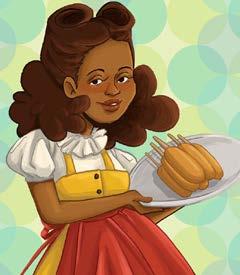How to really make your favorite classic “American” dishes
Written by Stephanie Dejak
Illustrated by Angela Enaiho

All-American Corn Dogs
What you’ll need:
12 German frankfurters
12 wooden sticks
1 ½ cups fine yellow Iroquois cornmeal
1 ¼ cups all-purpose flour
¼ cup granulated sugar
1 tbsp baking powder
¼ tsp salt
1 ¾ cups buttermilk
1 large egg
1 tbsp olive oil or vegetable oil
1 tbsp honey
Extra peanut or vegetable oil for frying
Instructions:
1)
Pour 2 to 3 inches of oil in a large pot and heat to 350°F over medium heat. While your oil’s heating, it’s worth contemplating if an “All-American Corn Dog” should even be considered an American classic at all.
2)
For a true American corn dog, borrowing the concept of a frankfurter from Europe is essential. You could substitute prepackaged hot dogs from your local Publix or Kroger for this recipe, but note that the taste will vary greatly from the real American way — which isn’t an American way at all, but a German one.
3)
After all, the first hot dogs were eaten in Frankfurt in 1484, 8 years before Christopher Columbus set sail for the “New World” and nearly 300 years before America became an independent nation.
4)
Regardless of if your frankfurters are truly American or not, the next step is piercing them with the wooden sticks. You’ll also want to make sure that your frankfurters are patted dry with a paper towel before covering them in the cornbread batter. This will ensure that the batter will stick better to the frankfurter.
5)
For the cornbread batter, using the Native American method of grinding dried corn into corn flour and adding water will provide the most traditional flavor for this dish. Thousands of years ago, this method was originally used by the Iroquois tribe in modern-day Ontario and upstate New York. But cornbread was, of course, eventually adopted by European settlers.
6)
Whisk together your dry ingredients (cornmeal, flour, sugar, baking powder, and salt). In a separate bowl, add your buttermilk, egg, oil, and honey. Whisk together the wet ingredients, then combine them with the dry ingredients and whisk again.
7)
Pour as much cornbread batter as you can into a drinking glass and start dipping your frankfurters. The best technique is dipping them straight down, giving them a twirl at the bottom to fully coat them, and swirling the stick as you lift back up. Let the excess batter drip off.
8)
Hold the corn dog at an angle in the hot oil for 5 to 7 seconds. This will allow the batter to seal so that it doesn’t stick to the bottom of your pot.
9)
After a few seconds, drop the corn dog into the oil. Fry for 3 minutes or until golden brown. To avoid dropping the oil’s temperature, it’s best to fry up to 2 or 3 corn dogs at a time, turning them as needed to brown evenly. Transfer to a wire rack to cool.
10)
Serve with condiments of your choice, but ketchup, mustard, and an epiphany of good old fashioned American miseducation are recommended.
BBQ Bacon Cheeseburgers
What you’ll need:
6 strips of Cantonese lap yuk
2 pounds ground beef
½ tbsp garlic powder
½ tbsp salt
½ tbsp black pepper
½ tbsp paprika
1 tbsp Caribbean barbecue sauce
6 slices pepper jack cheese
6 German hamburger buns, split and toasted
Instructions:
1)
If you’re hosting a Fourth of July cookout this summer, these BBQ Bacon Cheeseburgers are a fan favorite that your guests won’t stop talking about. You can practically taste the land of the free and the home of the brave in just one bite of this classic American cheeseburger.
2)
To begin, heat a large skillet over medium heat and line a large plate with paper towels. Once your skillet is hot, begin adding your Cantonese lap yuk.
3)
Believe it or not, lap yuk is known to most of the globe as an essential component of a traditional American breakfast. Your local Waffle House might have it listed as “bacon” instead, but this American staple is hardly American in actuality. In 1500 B.C., the Chinese became the first to serve cured pork bellies with salt.
4)
Cook your lap yuk for 4 to 5 minutes on each side. If you prefer a crispier cut, you can leave it cooking for an extra minute or so. Let the lap yuk rest on the paper towels until ready to serve.
5)
In a large bowl, combine ground beef, garlic powder, salt, pepper, and paprika. Shape into patties that are about ¾ of an inch thick.
6)
In the same skillet (or a grill if you have one), cook the patties over medium heat for 5 to 7 minutes on each side, adding a slice of pepper jack cheese during the last minute of cooking.
7)
Once the cheese is melted, it’s time to start assembling your burgers — which, unfortunately, can’t take credit for being American either. Although the hamburger was introduced to America as a brand-new food at the St. Louis World’s Fair in 1904, this popular fast-food sandwich dates all the way back to the 12th century and has origins in Hamburg, Germany.
8)
Split and toast your German hamburger buns, then add your cheeseburger to the bottom bun, placing a strip of lap yuk on top. The top bun is reserved for the star ingredient of this burger: the barbecue sauce.
9)
The most authentic American barbecue sauce is not tomatobased or from Texas; it’s not made from vinegar in North Carolina, and it’s certainly not the bottle of Sweet Baby Ray’s in your fridge. In fact, barbecue sauce existed nearly a hundred years before the United States ever did.
10)
Although its flavors have African influences, the sauce itself originated in the West Indies in the late 17th century. Yearning for a taste of home, African slaves in the Caribbean at that time added a mixture of lime juice and hot peppers to their slow-roasted pork. Eventually, the scarcity of limes in America forced substitutions of vinegar and tomato, which is when Southerners began claiming barbecue sauce as their own.
11)
Spread about a tbsp of barbecue sauce — whether it’s Caribbean or American or somewhere in between — over the bottom of the top bun. Close your burgers and serve.
12)
When you take a bite, ask yourself, does this taste like the land of the free? Does this taste like the home of the brave? Or does erasing its true origins leave a bad taste in your mouth?
Grandma’s Apple Pie
What you’ll need: (for the Dutch pie crust):
2 ½ cups all-purpose flour
½ tbsp granulated sugar
½ tsp sea salt
2 sticks cold unsalted butter, diced into ¼ inch pieces
7 tbsp ice water
What you’ll need: (for the filling):
6 or 7 Australian Granny Smith apples, peeled and cored
1 ½ tsp cinnamon
8 tbsp unsalted butter
3 tbsp all-purpose flour7 tbsp ice water
¼ cup water
1 cup granulated sugar
1 egg and 1 tbsp water, for egg wash
Instructions:
1)
Like Grandma always said, don’t forget to save room for dessert! There isn’t a dessert out there that’s more American than apple pie. After all, it wouldn’t really be considered a true American classic if it wasn’t stolen from another culture, right?
2)
In the 15th century, Dutch bakers elevated an old English recipe by adding a sugary crust to a bland apple dish, creating the modern apple pie as we know it.
3)
To make a Dutch pie crust, begin by placing flour, sugar, and salt into the bowl of a food processor and pulse a few times to combine.
4)
Add cold diced butter and pulse the mixture until coarse crumbs form into pea-size pieces, then stop mixing. At this stage, your mixture should have a dry, powdery texture.
5)
Next, add ice water and pulse just until small clumps form. Press a piece of dough between your fingertips, and if the dough sticks together, you’ll know that you’ve added enough water. If not, add more water a teaspoon at a time. Be careful not to add too much water, or the dough will become too sticky to roll out.
6)
Transfer your dough to a clean work surface and roll it into a smooth ball.
7)
Divide dough in half and flatten to form 2 disks. Cover with plastic wrap and refrigerate for one hour. After an hour, preheat your oven to 425°F.
8)
While the dough rests, consider why Americans decided to coin the phrase “as American as apple pie” as an expression of patriotism in the 1940s — approximately 500 years after the Dutch pioneered the modern apple pie recipe — despite the recipe and its main ingredient originating from elsewhere. Your guess is probably about as good as mine.
9)
For the apple filling, melt remaining butter in a medium saucepan over medium heat. Add in flour and whisk constantly for 1 minute.
10)
Then, whisk in remaining sugar and water and bring to a boil. Reduce heat and continue simmering for 3 minutes, whisking frequently. Remove from heat.
11)
Peel and core 6 or 7 Granny Smith apples, which were deemed the “Best Cooking Apple” in their native environment of Australia in the 1890s. But Granny Smiths didn’t exist in our “American” apple pies (or in American supermarkets, for that matter) until the 1970s.
12)
Thinly slice your Australian Granny Smith apples and place them in a large bowl. Sprinkle with cinnamon and toss to combine. Pour in the sauce and stir to coat the apple slices.
13)
Sprinkle your work surface with flour and roll out the bottom pie crust into a circle with a 12-inch diameter. Wrap it around your rolling pin and transfer to a 9-inch pie dish.
14)
Add the apple mixture, creating a slight mound in the center. Try to avoid getting the filling on the edges because it might make your pie difficult to seal.
15)
Roll a second crust into an 11-inch circle and cut into 10 evenly thick strips using a pizza cutter. Using the Dutch method, arrange the strips in a woven lattice pattern over the top of the pie.
16)
Quickly beat together 1 egg and 1 tbsp water to create an egg wash. Brush the egg wash over the lattice pattern before baking.
17)
Bake at 425°F in the center of the oven for 15 minutes. Then, reduce heat to 350°F and continue baking for another 45 minutes, or until the apples are soft. Rest at room temperature for 1 hour before serving.
18)
Relish in the sweet realization that although America is a thief, we do reap delicious benefits.


